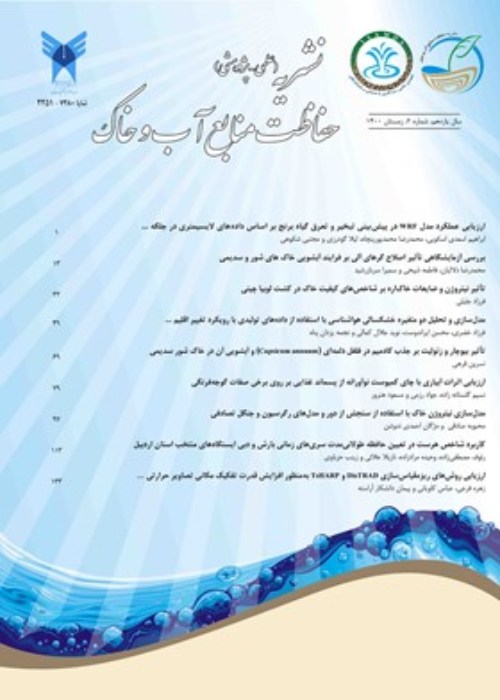Investigating the Spread of Pollution in the Porous Environment of the Babol Aquifer by MODFLOW and MODPATH Models
Due to the sharp decline of the underground water in the country's plains due to their indiscriminate extraction for agricultural purposes, managers are looking for solutions to manage and restore underground water tables. One of the solutions to compensate for the drop in the underground water level, which is one of the most effective factors in destroying the discharge capacity and increasing the quality in the underground water area, scenarios of reducing withdrawal of farming wells and prepare prohibition plans with the least uncertainty based on the regional sensitivity to pollution. The purpose of this research is to predict the flow and pollution conditions of the area based on numerical models, so that the level network and the direction of the underground water flow of the plain using MODFLOW software in a long-term period and the development of the prediction model using Calibration and validation operations should be performed on the base period of the studies in order to be able to implement the forecast scenarios by applying restrictions and reducing harvesting on aquifer exploitation resources, and specifically agricultural wells, until the stage of stable hydrograph extraction of the plain.
This research was carried out with the aim of estimating and predicting the state of pollution in the urban pollution site, using MODFLOW and MODPATH computer programs in GMS software. To achieve this goal, in the first step, the numerical model of the aquifer flow was prepared and calibrated by the MODFLOW code. Then, the MODPATH code was used to track the contaminated particles in the steady-state progressive method. In the second stage, the impact of the scenario of increasing and decreasing the pumping from the exploitation wells on the travel time, the length of the path and the catchment area of the leachate particles leading to them was predicted and evaluated by the regressive method. In the third step, the tracking of particles leading to qualitative sampling wells in the plain was predicted and evaluated by regressive method in steady state.
According to the automatic calibration and validation approach, the underground water flow model produced the least statistical deviation on the optimization parameters. Also, the particle transfer quality model was correctly implemented on the groundwater flow prediction model. In the Babol aquifer, the waste disposal area outside the designated aquifer is saturated. It was observed that, by adjusting the parameters of the simulation of the transfer of residual pollution cloud particles, an estimate of the concentration was applied to the permeable boundaries and the channel network. This means that in the simulation of particle transport, here the source of pollution spread is the channel network and permeable boundaries, which will be directly affected by pollution during periods of rainfall and especially floods. The concentration limit was given to the model in the form of variable figures based on discharge and precipitation in the range and equal to the primary stable threshold of the research subject (landfill). Based on the cumulative diagram of the outlet concentration from the permeable boundary and flow channel in the southeast region, the trend of changes in the cloud pollution concentration diagram, in the qualitative modeling of the plain, shows that in the forecast period, the increase in concentration will increase linearly. Considering that the waste disposal location is outside the plain, the rate of increase in pollution was not very high until the end of the initial simulation. However, the reason for the increase in concentration accumulation volume can be related to the existence of permeable boundaries and severe drop of underground water in this area. In other words, when the underground water level drops too much in the saturation area of the plain, the direction of the flow will move the volume of polluted water towards the aquifer at a higher speed.
If the situation of groundwater withdrawals continues in the same way, in addition to the reduction of the groundwater storage of the plain, the quality of the remaining water storage will also decrease. This causes more serious problems in the agricultural situation of the region. The results of the implementation of quantitative and qualitative model in order to investigate the infiltration of polluted water from the landfill based on the concentration of pollution, showed that there is a high probability of the infiltration of polluted particles from the south wall side to the aquifer during periods of rainfall Event that current is run in the channels accidently. and then the expansion to the sea will actually occur due to the drop in the water level of the Caspian Sea. Water infiltration is more likely in the eastern regions than in the western regions. The reason for choosing the spread of pollution from the eastern waste disposal site in order to show the accumulation of polluted particles and the repulsion from the sea was the same. It is suggested that in the field of policy making, in order to control the plain's leachate crisis, appropriate bed construction and walling of the waste accumulation area should be applied based on the flow direction.
- حق عضویت دریافتی صرف حمایت از نشریات عضو و نگهداری، تکمیل و توسعه مگیران میشود.
- پرداخت حق اشتراک و دانلود مقالات اجازه بازنشر آن در سایر رسانههای چاپی و دیجیتال را به کاربر نمیدهد.


